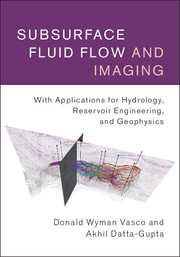 Subsurface Fluid Flow and Imaging
Subsurface Fluid Flow and Imaging Book contents
- Frontmatter
- Contents
- Preface
- Acknowledgments
- 1 The propagation of a disturbance in relation to imaging
- 2 Principles and equations governing fluid flow and deformation
- 3 Trajectory-based modeling
- 4 Equations in diffusion form
- 5 Equations governing advection and transport
- 6 Immiscible fluid flow
- 7 Coupled deformation and fluid flow
- 8 Appendix: a guide to the accompanying software
- References
- Index
- Colour plate section between pages 150 and 151
2 - Principles and equations governing fluid flow and deformation
Published online by Cambridge University Press: 05 July 2016
- Frontmatter
- Contents
- Preface
- Acknowledgments
- 1 The propagation of a disturbance in relation to imaging
- 2 Principles and equations governing fluid flow and deformation
- 3 Trajectory-based modeling
- 4 Equations in diffusion form
- 5 Equations governing advection and transport
- 6 Immiscible fluid flow
- 7 Coupled deformation and fluid flow
- 8 Appendix: a guide to the accompanying software
- References
- Index
- Colour plate section between pages 150 and 151
Summary
Introduction
In this chapter we review the basic governing equations for fluid flow in permeable media. Our treatment is general and includes coupled deformation and fluid flow. Starting with the basic conservation laws we derive the pressure and transport equations for single phase and multiphase flow in porous media. We cover physical processes involving both miscible and immiscible displacements as well as mass transfer from compositional effects and present the equations describing these processes. We have included a fairly extensive discussion on the underlying principles behind elastic deformation and how the concepts carry over for modeling fluid flow in deformable porous media. We conclude the chapter with a discussion on poroelasticity and the associated equations for fluid flow in deformable porous matrix in the presence of one or more fluid phases. In summary, this chapter provides the foundation and notation for subsequent developments. However, in each of the subsequent chapters we will start with the relevant governing equations so the reader may comfortably skip this chapter and refer back to it as necessary.
Underlying principles
Motion, force, momentum, work, and energy
At the most basic level there are the concepts of motion and force. We can all agree when an object is stationary with respect to a ‘stable’ reference point. First, define a reference point in a chosen coordinate system by x0 and the position of our object in that coordinate system by the vector x. An object is considered stationary when its position relative to the reference point is unchanging, that is,
x − x0 = c,
where c is a constant. Such a motionless object is termed static. An object in motion changes its position over time and one may think of the position vector as a function of time x(t). In order to describe the motion of an object with some precision we define the velocity of an object v(t), the rate of change of an object's position with time, formally defined as the limit
where In addition, we also need a measure of the change of an object's velocity over time because the deviation from motion at a constant velocity is an important indicator that a force is pushing or pulling on the object, acting to change its motion.
- Type
- Chapter
- Information
- Subsurface Fluid Flow and ImagingWith Applications for Hydrology, Reservoir Engineering, and Geophysics, pp. 27 - 100Publisher: Cambridge University PressPrint publication year: 2016
